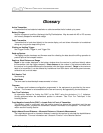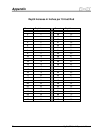
Glossary
®
Housing = Drill Tool = Drill Head
The downhole device into which the transmitter fits.
Locate Line and Points
See Positive Locate Line, Front Negative Locate Point, and Rear Negative Locate Point.
Magnetic Distance
The magnetic distance is used by the receiver to calculate the depth/distance of the transmitter. For
more information see “Ultrasonic Function” in the Receiver Section.
Mark III
Designation used to delineate DigiTrak Receivers with an improved design over the Mark I and Mark II
Receivers. The Mark III has special shielding that increases the range of any DigiTrak Transmitter
and helps decrease the effects of some types of interference.
Mark III Self-Test
Procedure for completing a self-diagnostic test on all the components of the receiver except the
ultrasonic transducers (other ultrasonic components are tested). The self-test must be completed in
an interference-free area and out of range of any active transmitters. For more information see “Self-
Test for Mark III Receivers” in the Operational Tests Section.
Metric Mode
The term used to describe depth measurements in centimeters.
Pitch
The angle or inclination of the transmitter relative to the horizontal displayed in percent (%) slope (rise
divided by run). DCI transmitters can measure and display pitch in both 1% and 0.1% increments.
Positive Locate Line (PLL) = Line Above Transmitter that Runs Perpendicular to the Transmitter
This location in conjunction with the FNLP and/or RNLP determines the position of the transmitter be-
low ground.
Predicted Depth
The predicted depth provides a prediction of the transmitter’s depth at the FNLP when the operator
holds in the receiver’s trigger. The predicted depth is displayed in the bottom window as a flashing
number and a solidly lit squiggle (“~”) symbol. For more information see “5.0 Series Firmware Func-
tions” in the Receiver Section and see the Locating Section.
Rear Negative Locate Point (RNLP) = Locate Point Behind Transmitter
This location is used in conjunction with the positive locate line and the FNLP to provide the trans-
mitter’s lateral location and direction of movement. For more information see the Locating Section.
Receiver
Also referred to in the HDD industry as a locator, it is the portable device that is used above ground to
receive the transmitter’s signals, process the signal information, and display the transmitter’s status to
the operator. The receiver may also be equipped with a telemetry transmitter to send information back
to a remote display at the drill rig.
Reference Line
A predetermined line or set of surface characteristics generally along the intended path of the bore
(used for reference during drilling). Mainly used when mapping bores using the DataLog System.
70 DigiTrak
®
Mark III Operator’s Manual


















